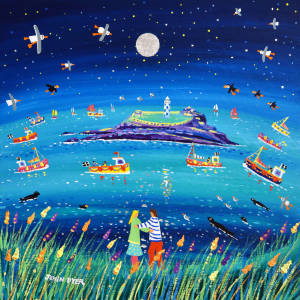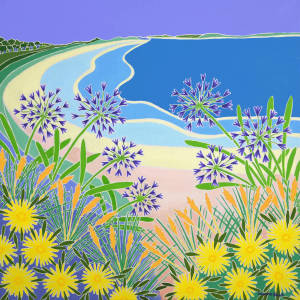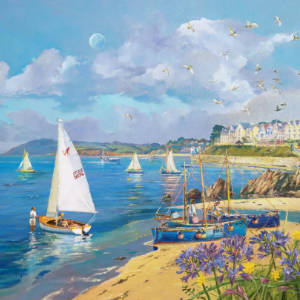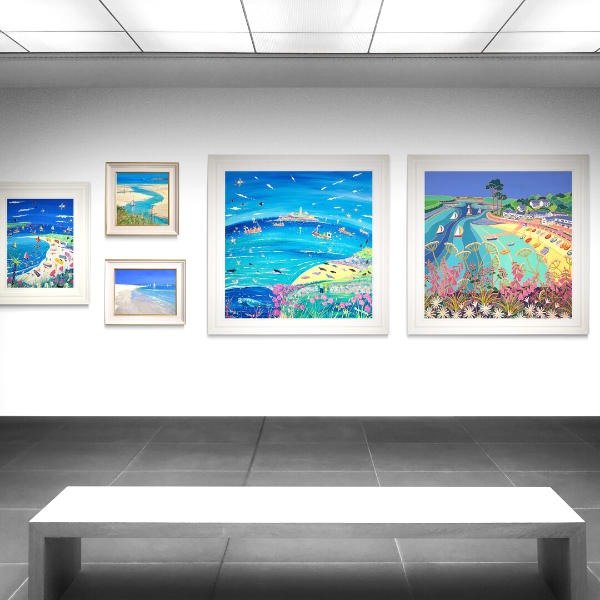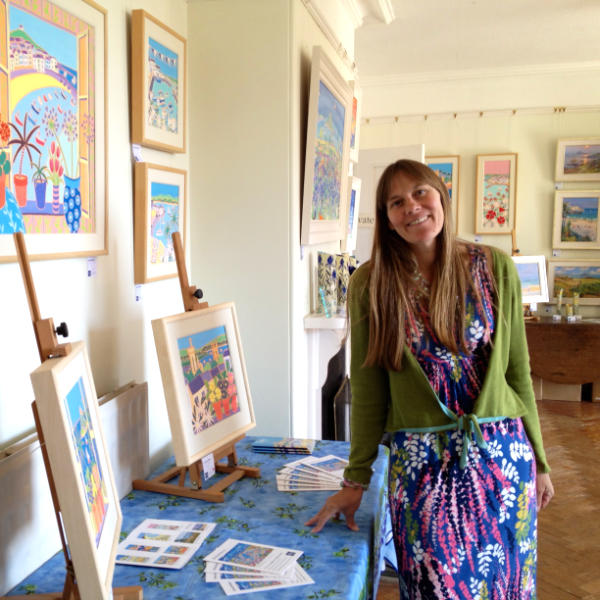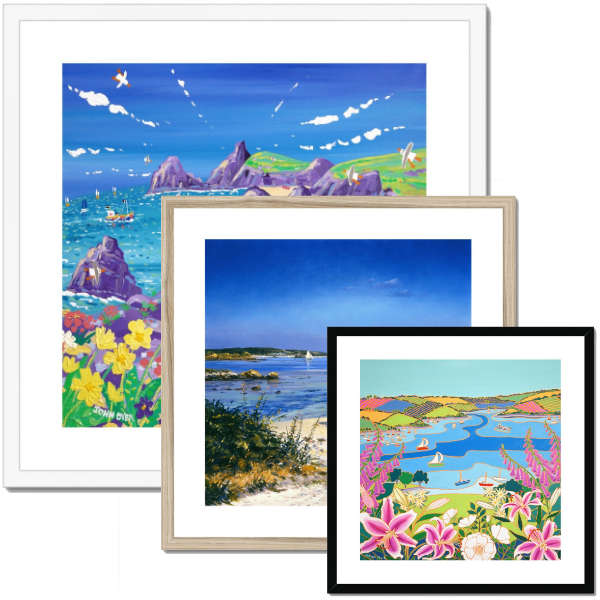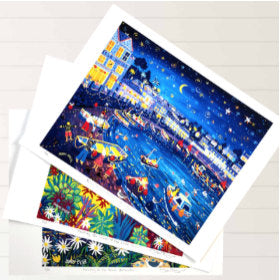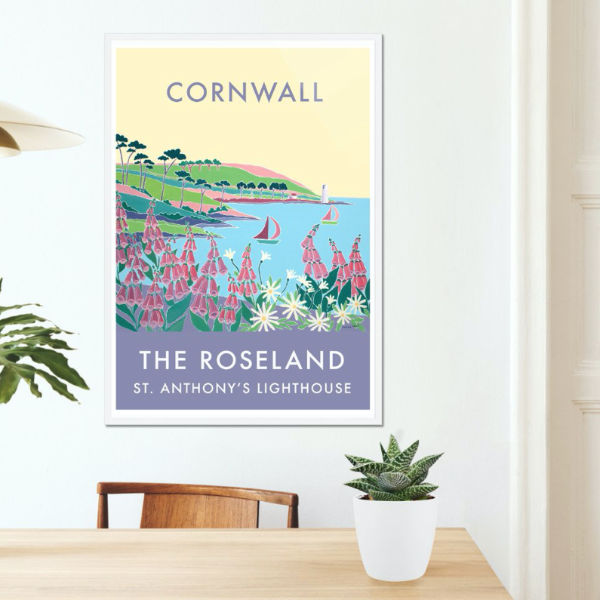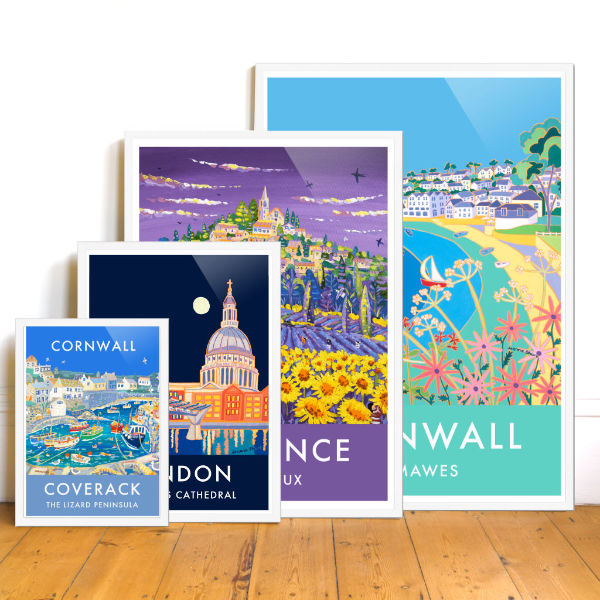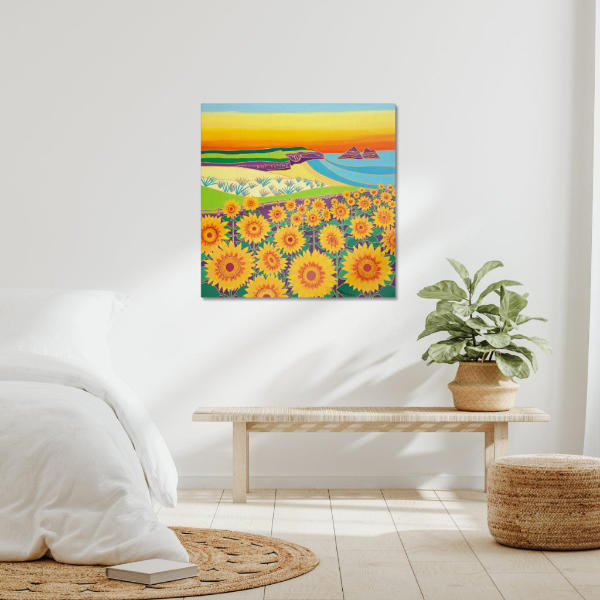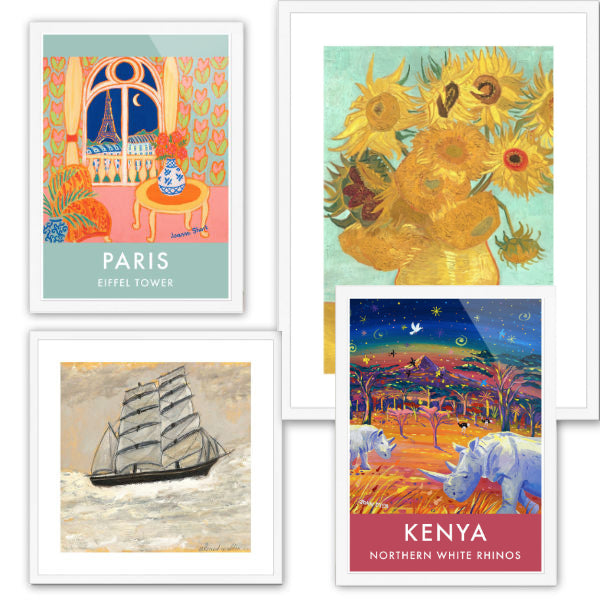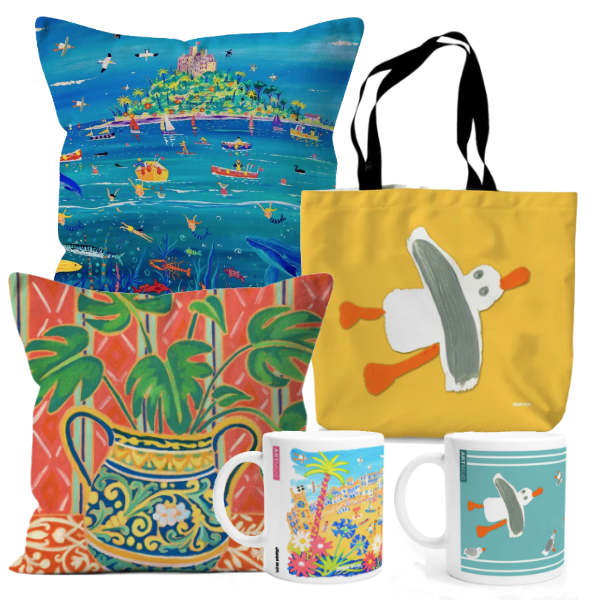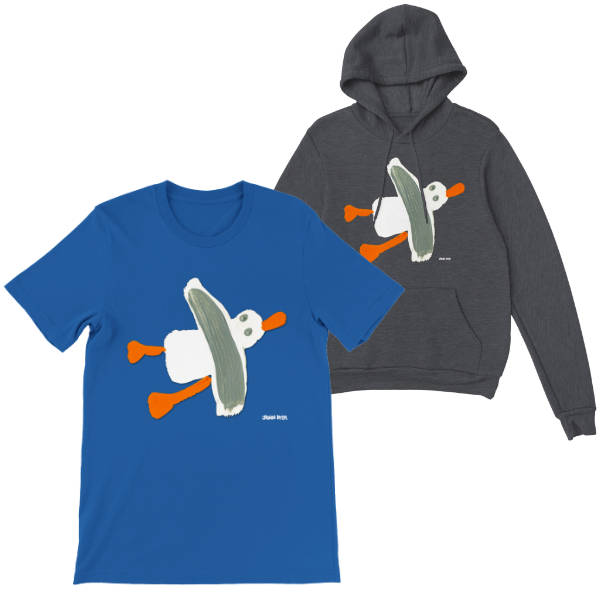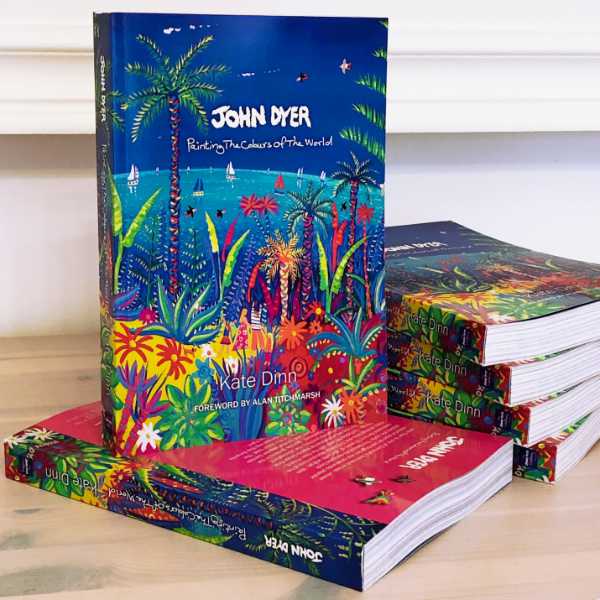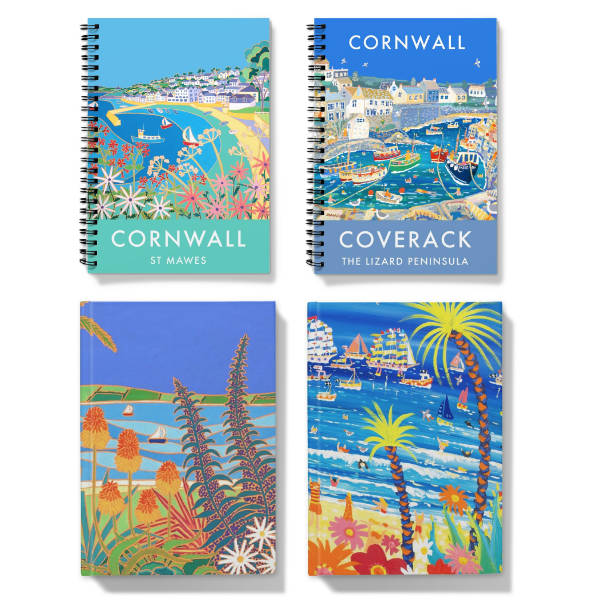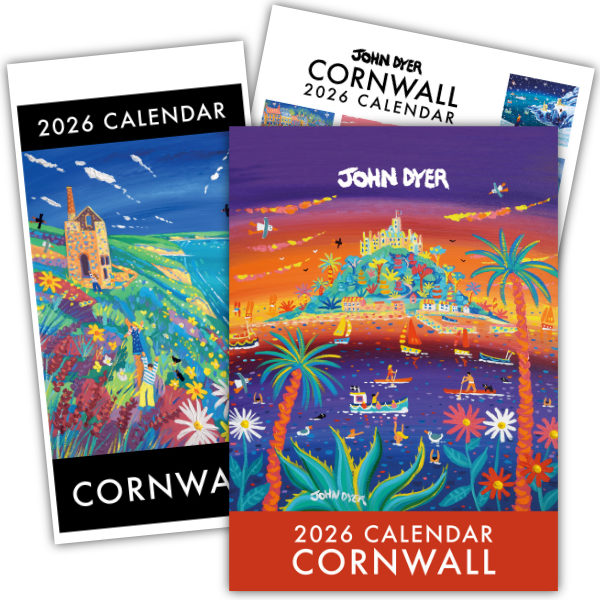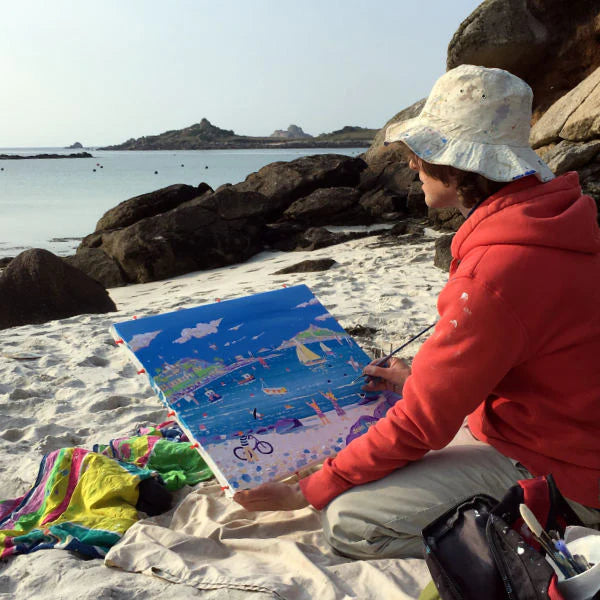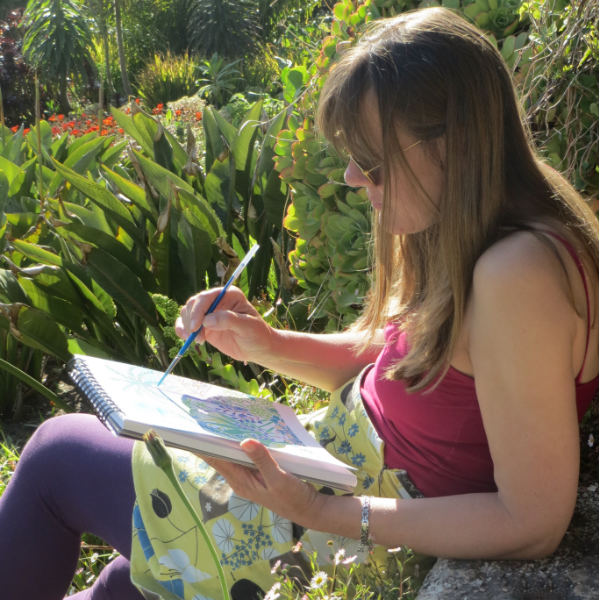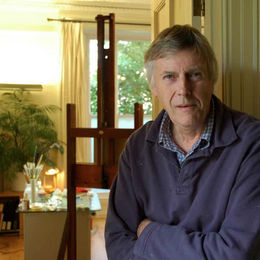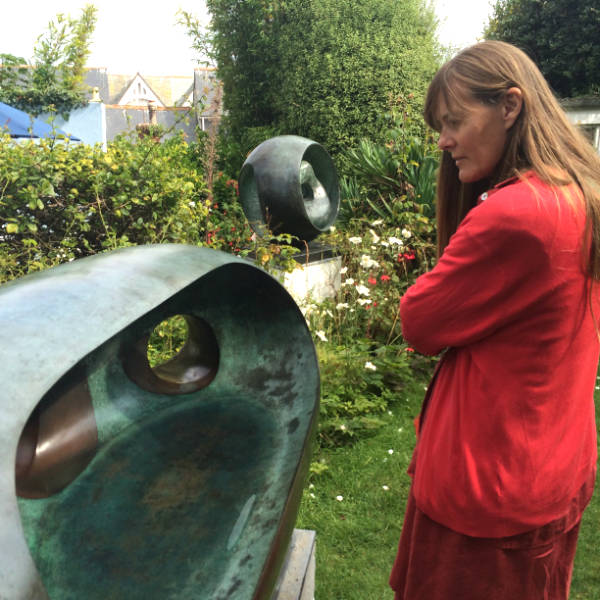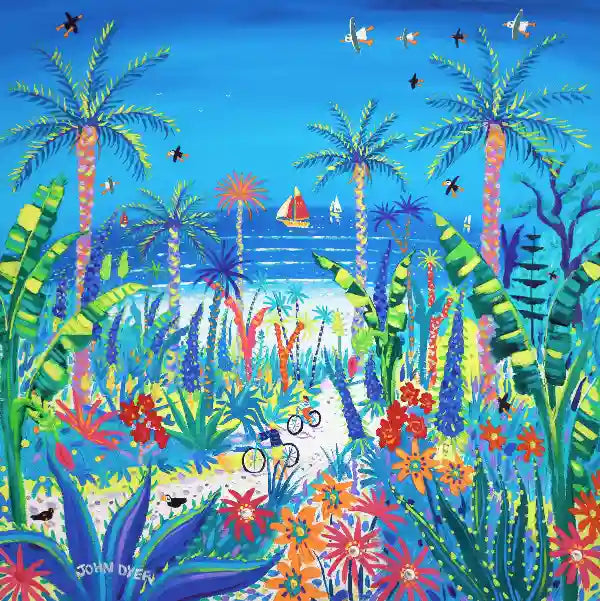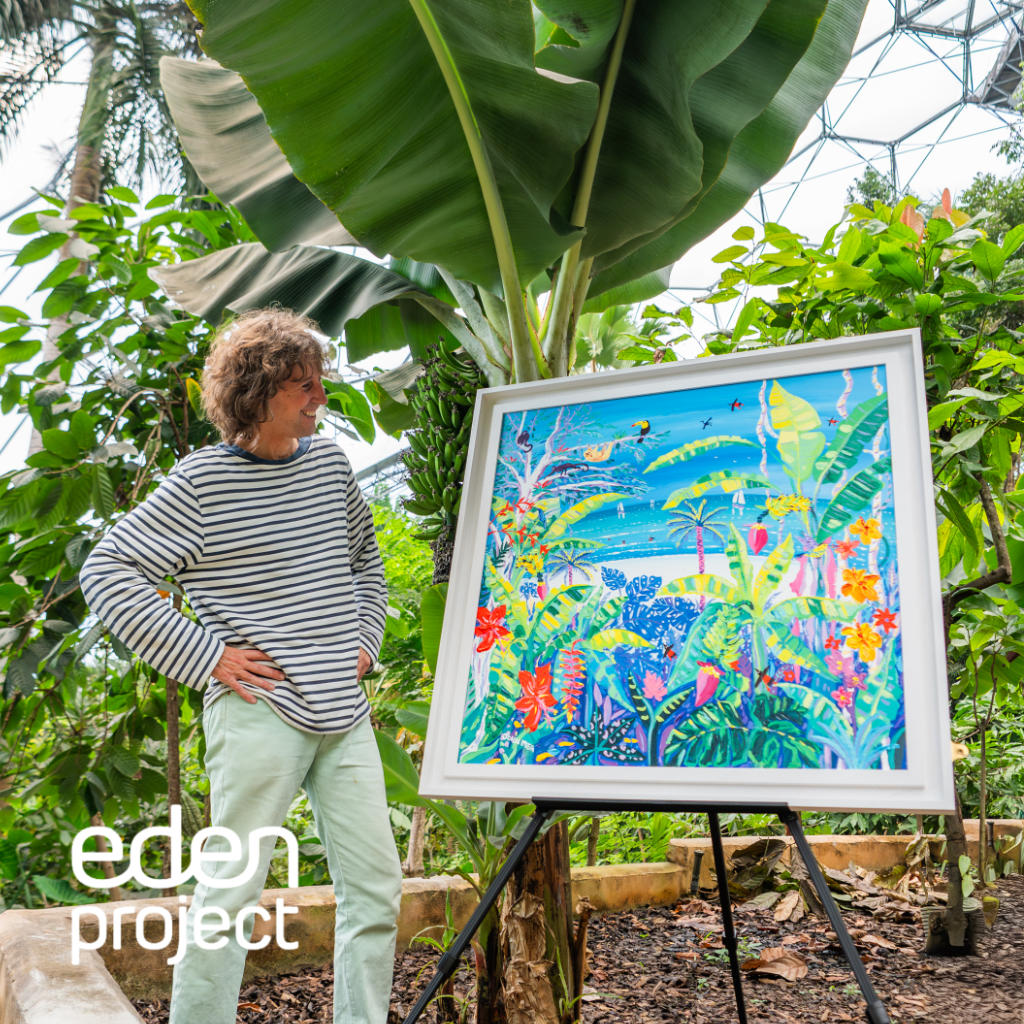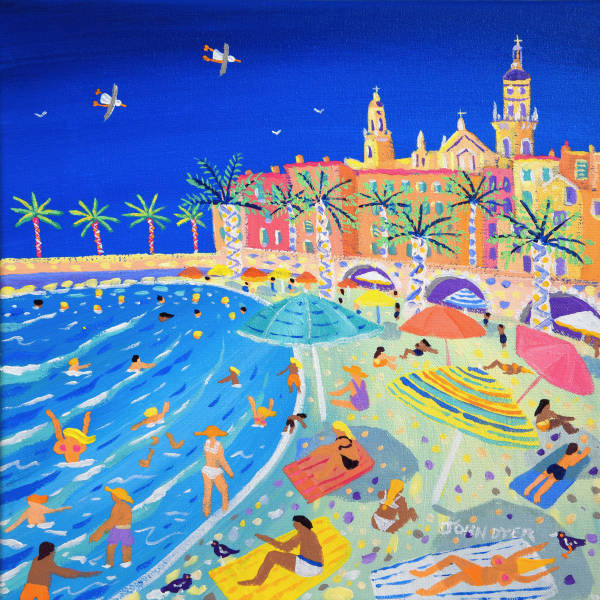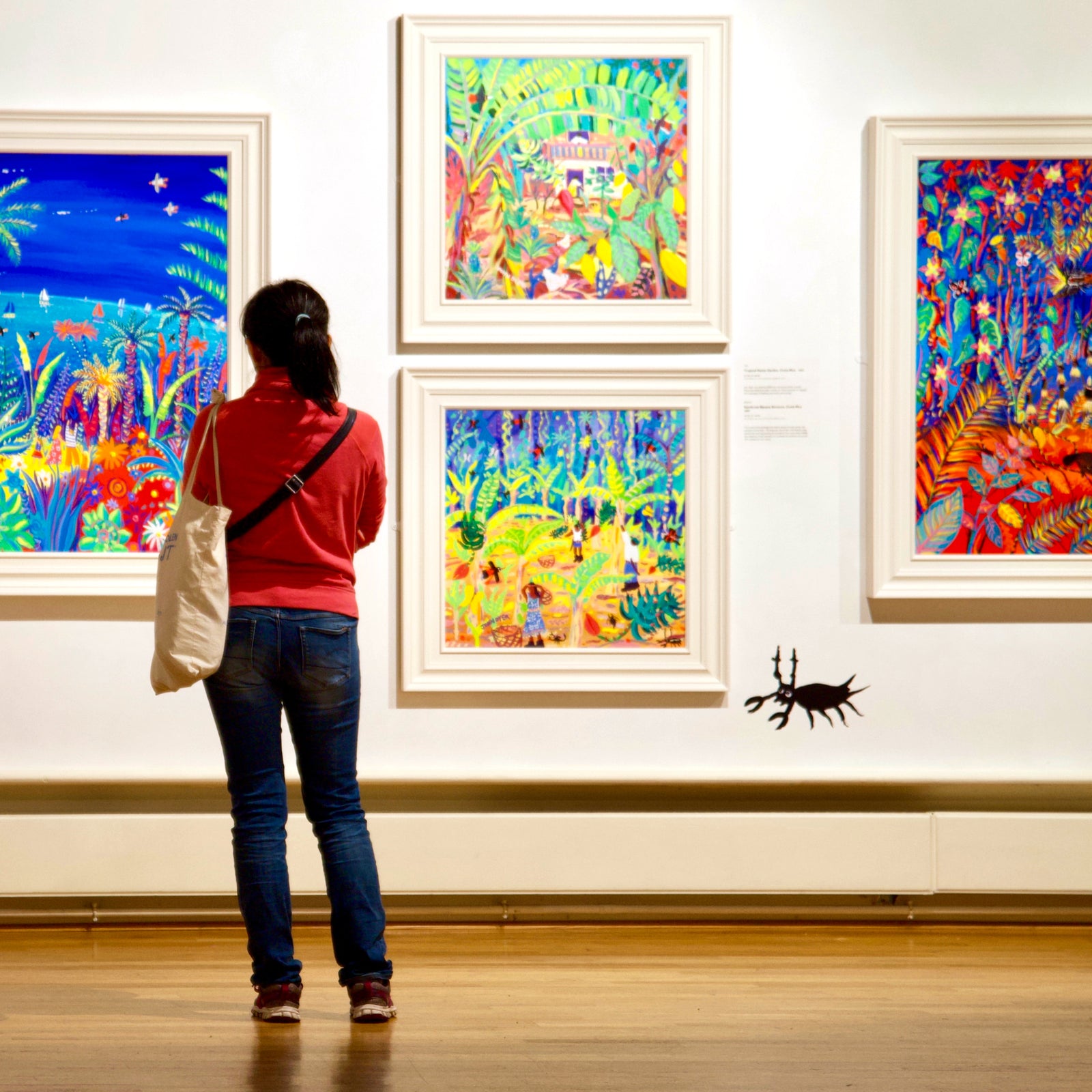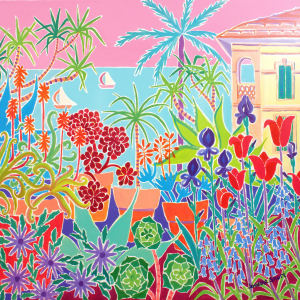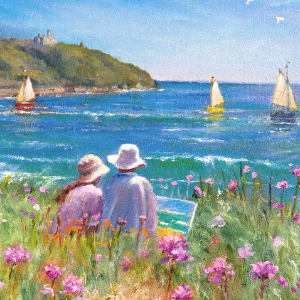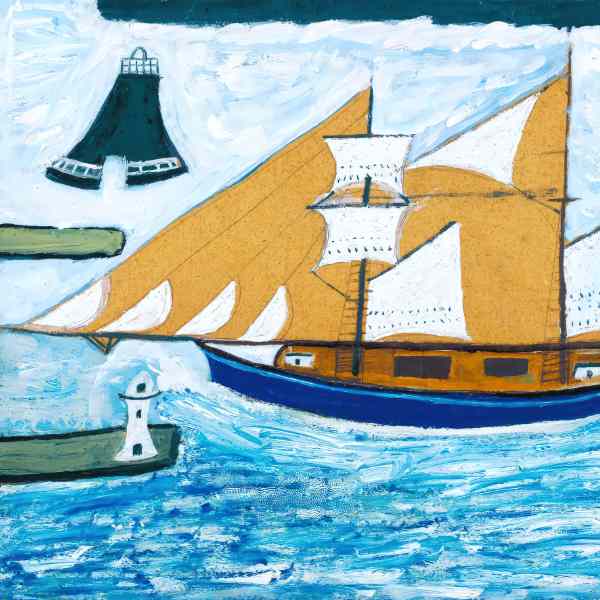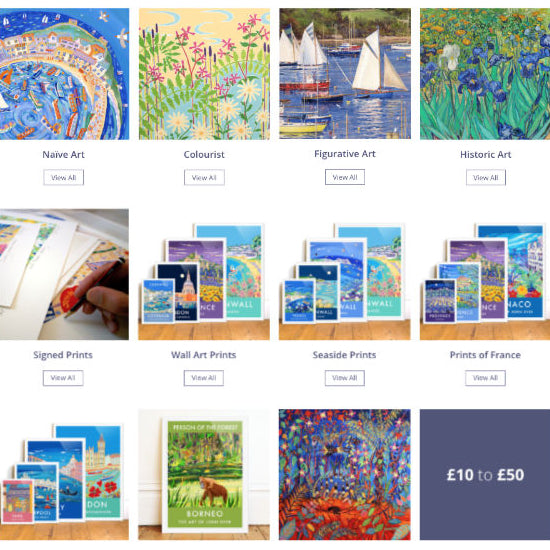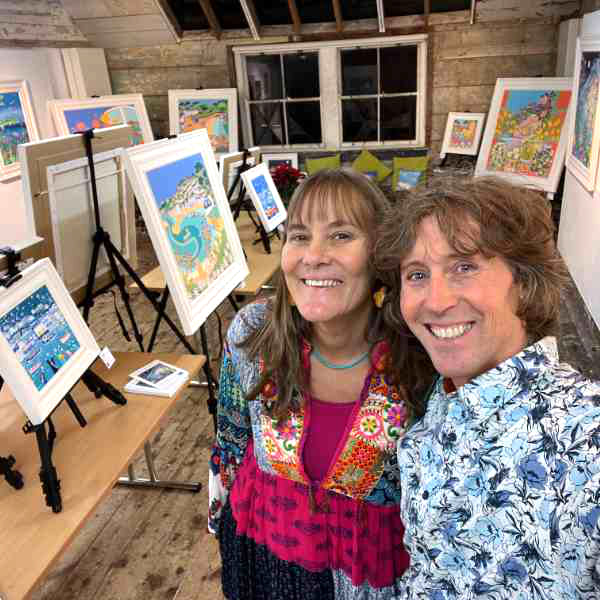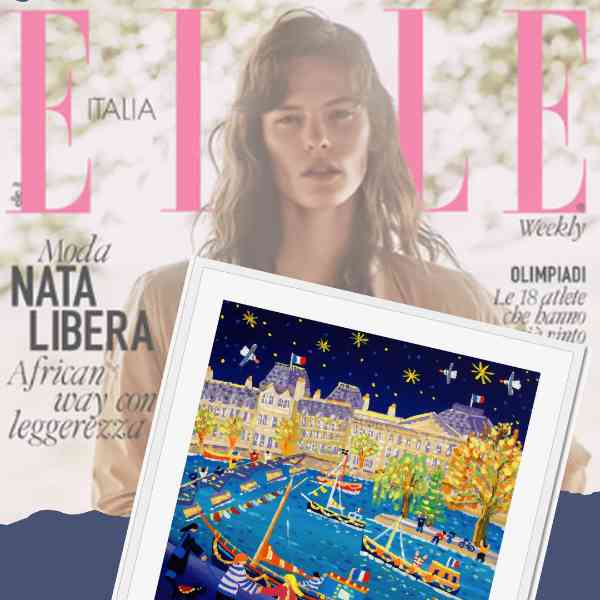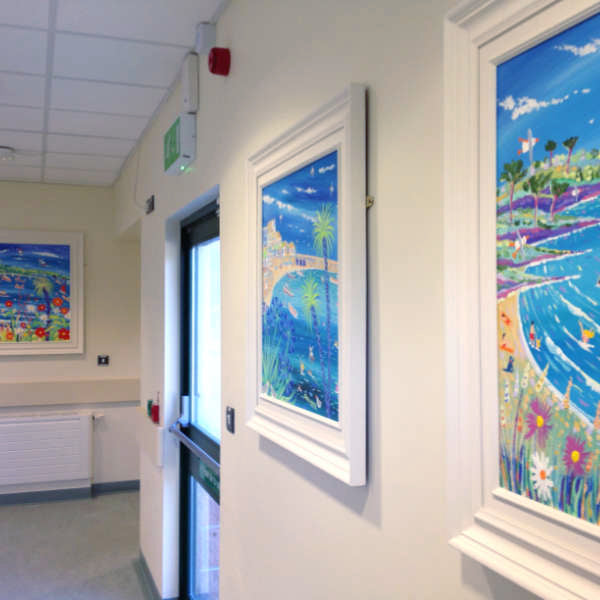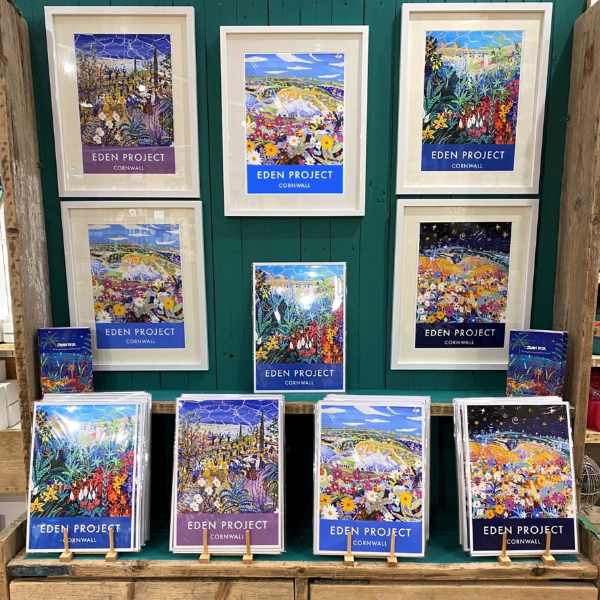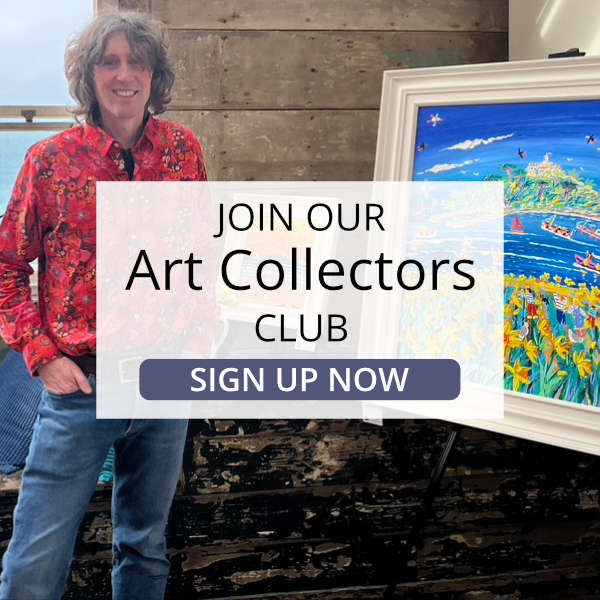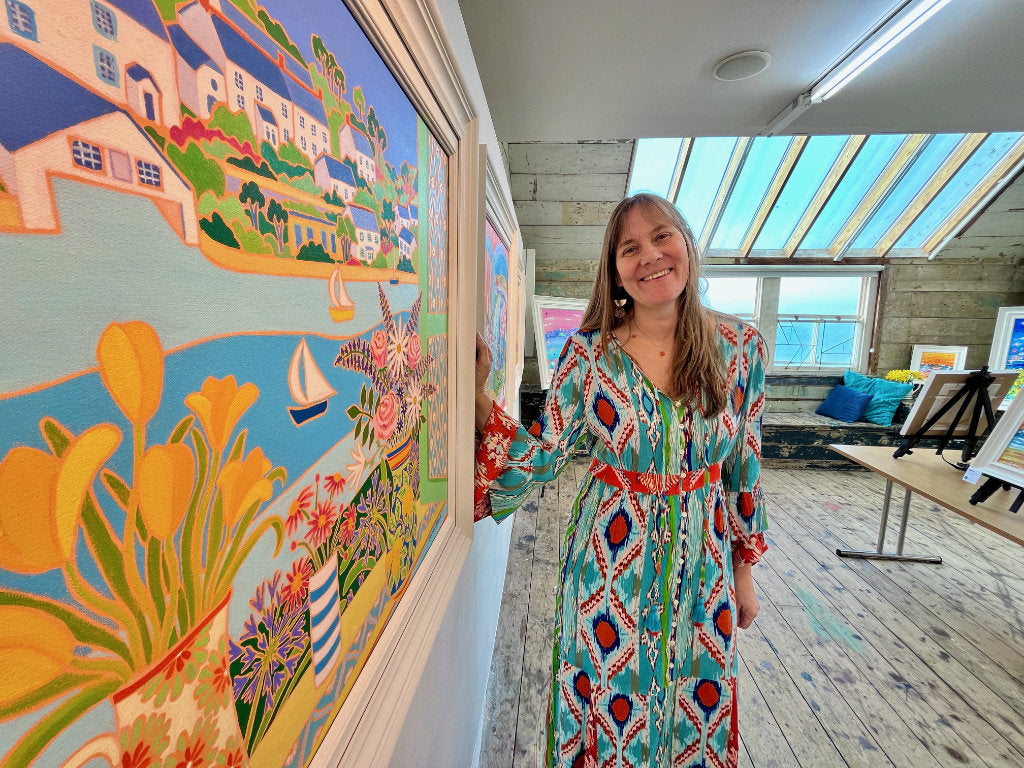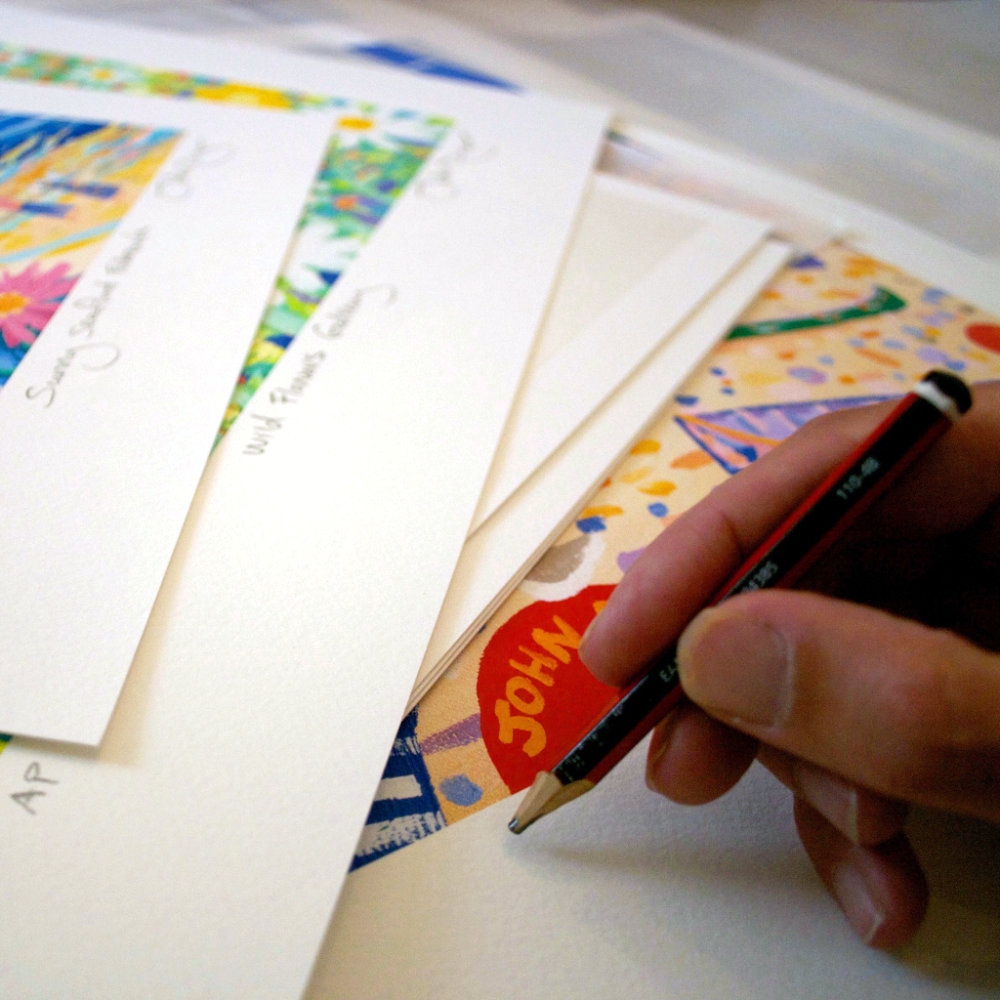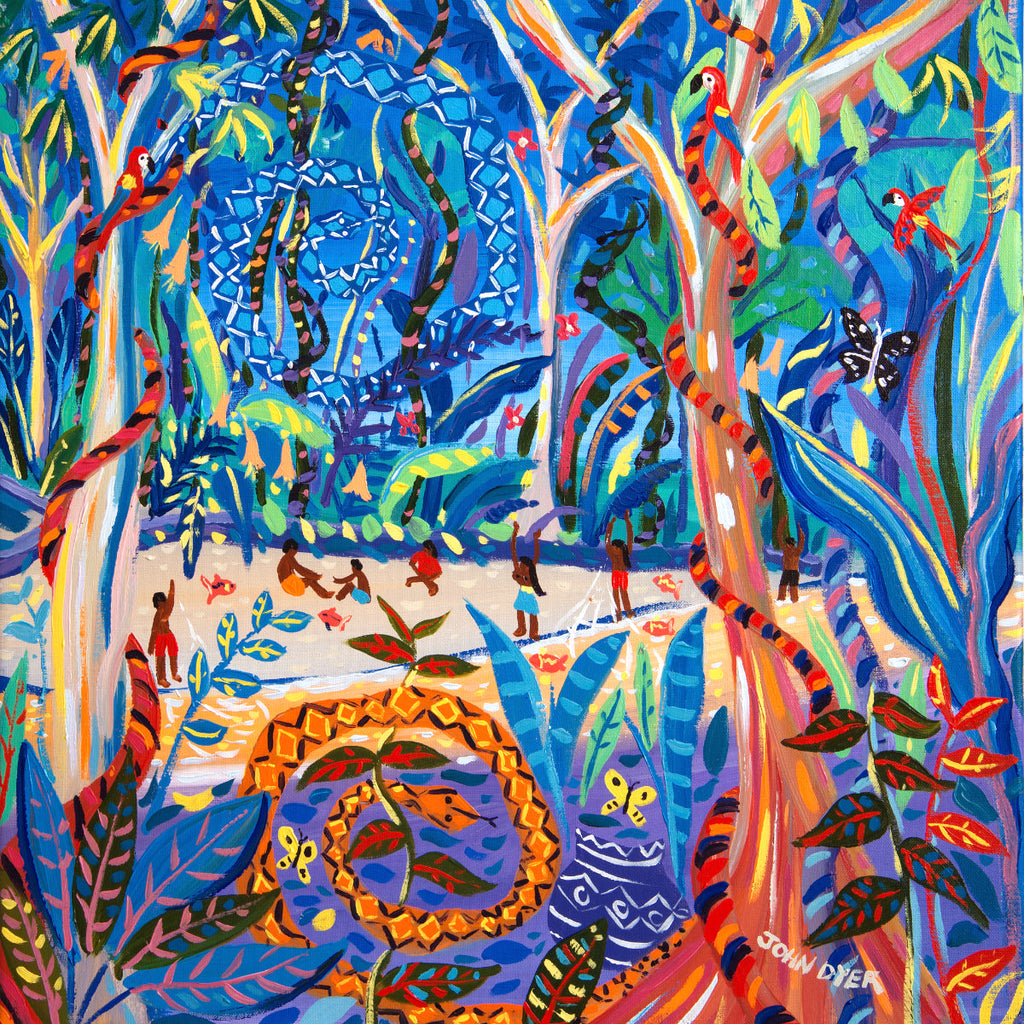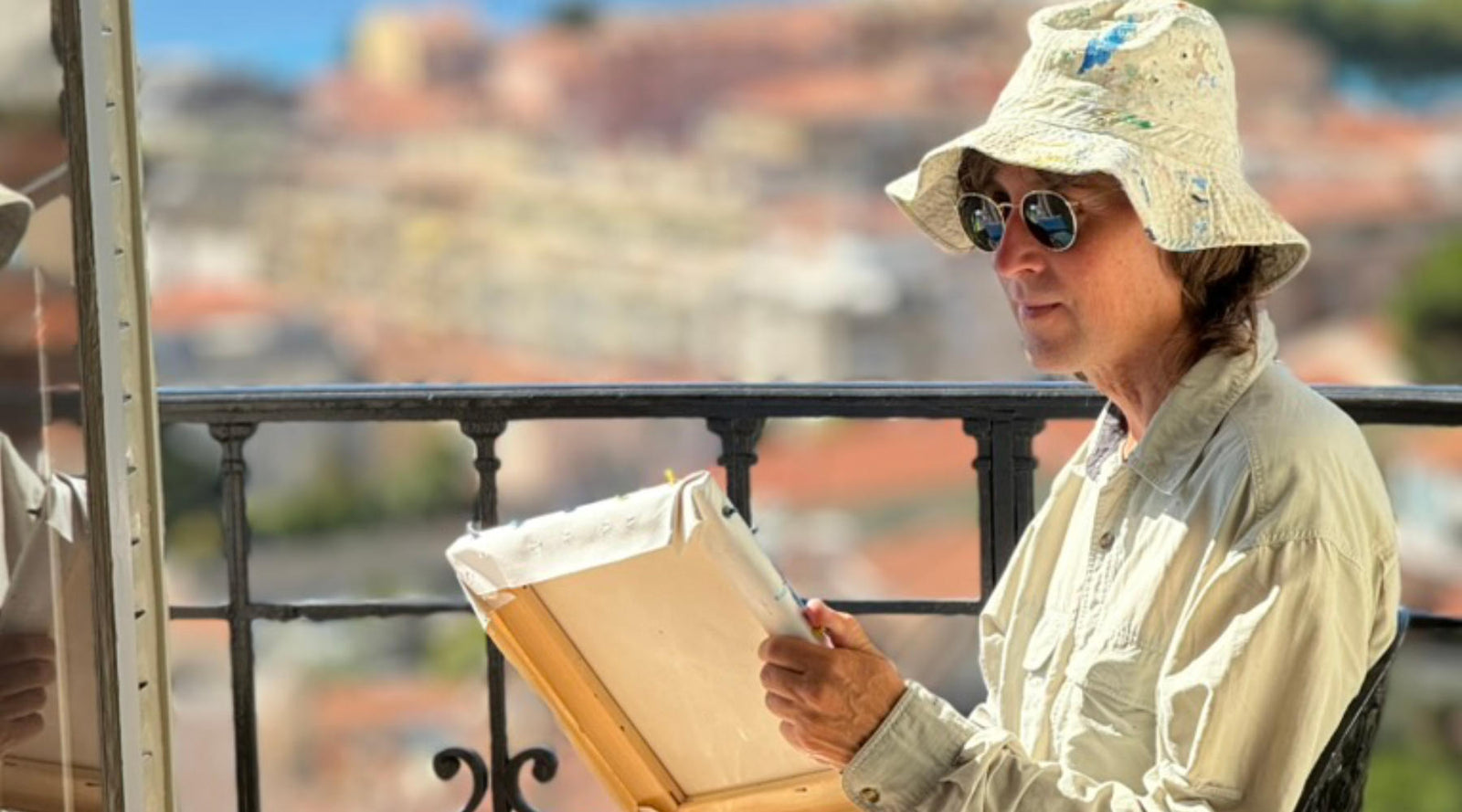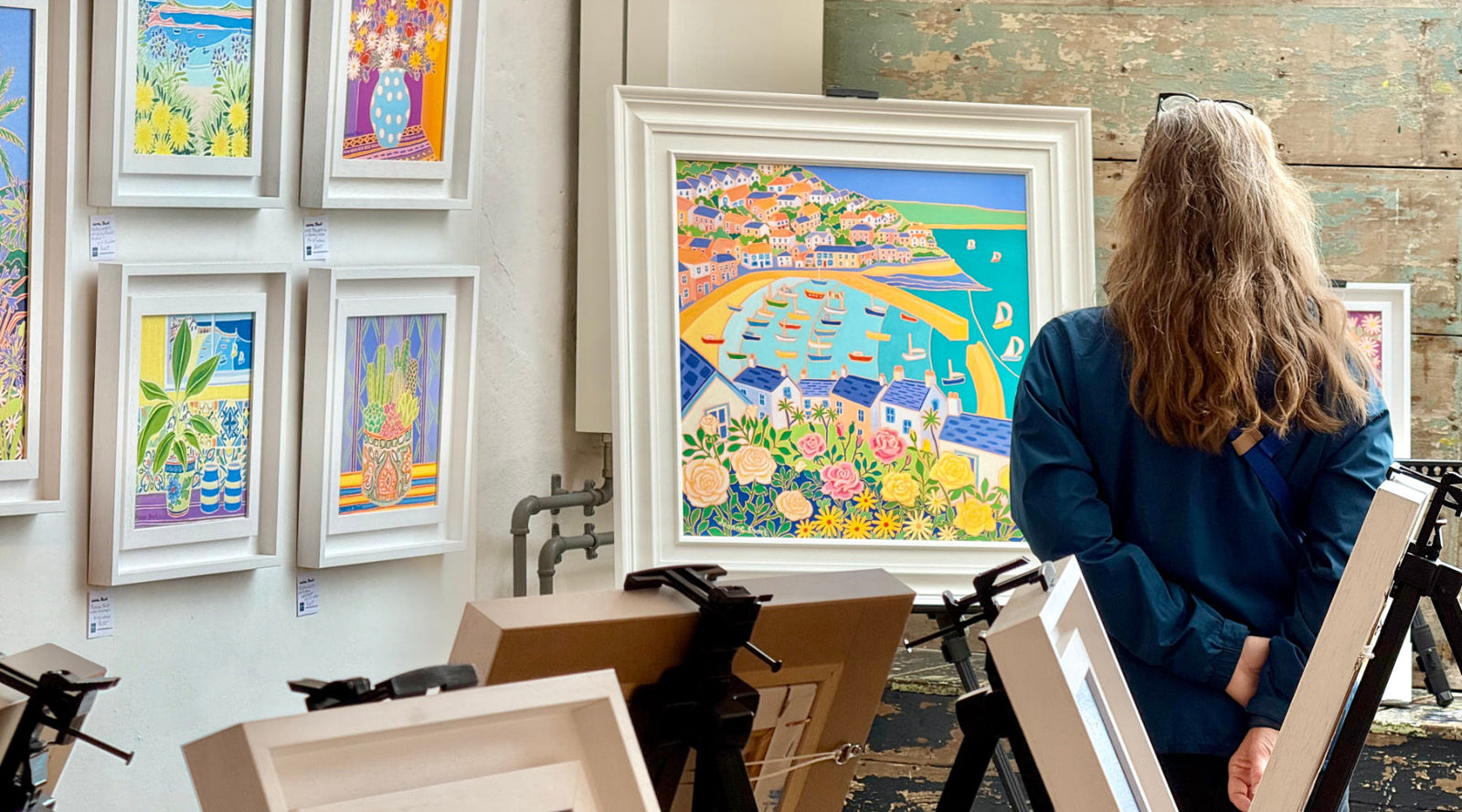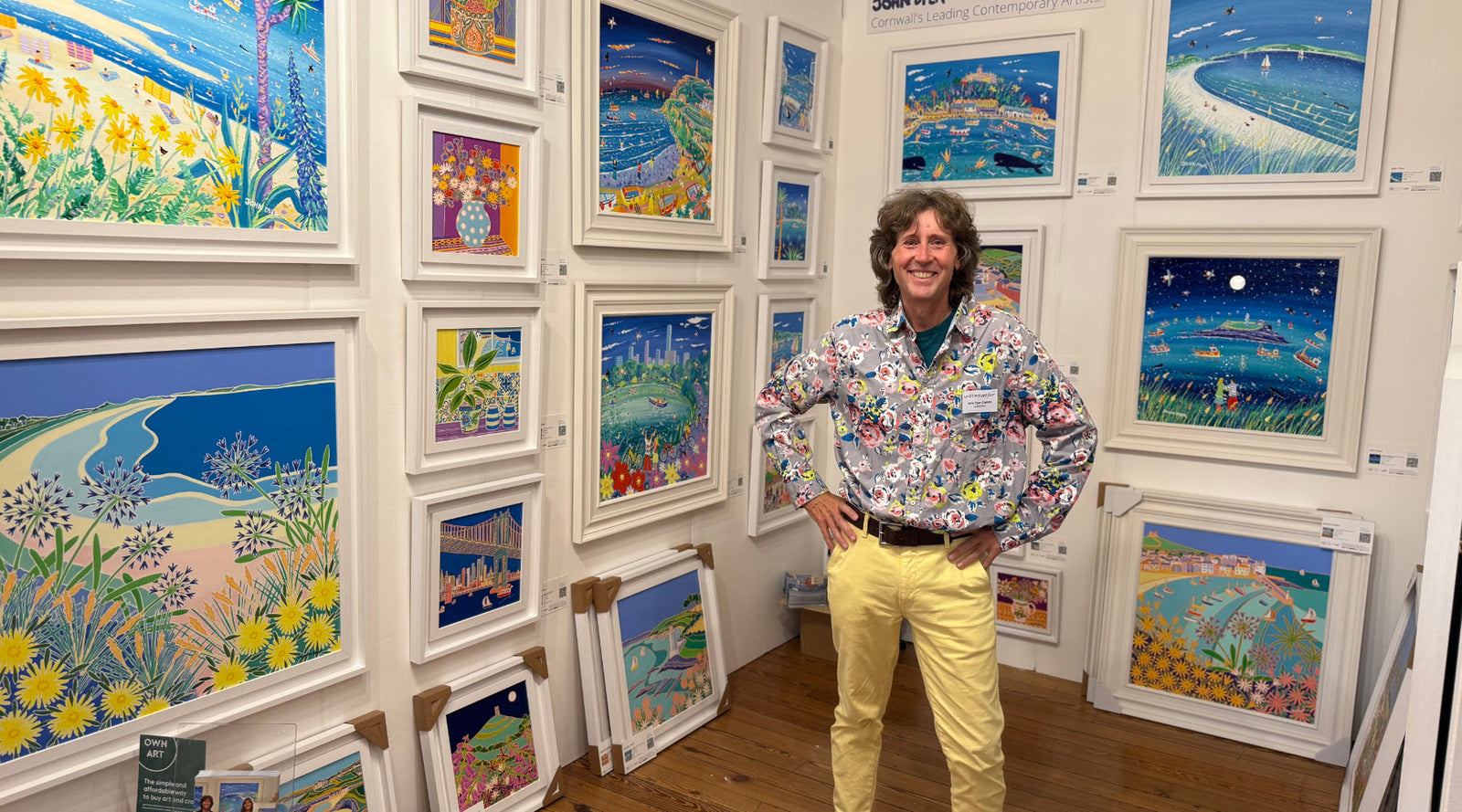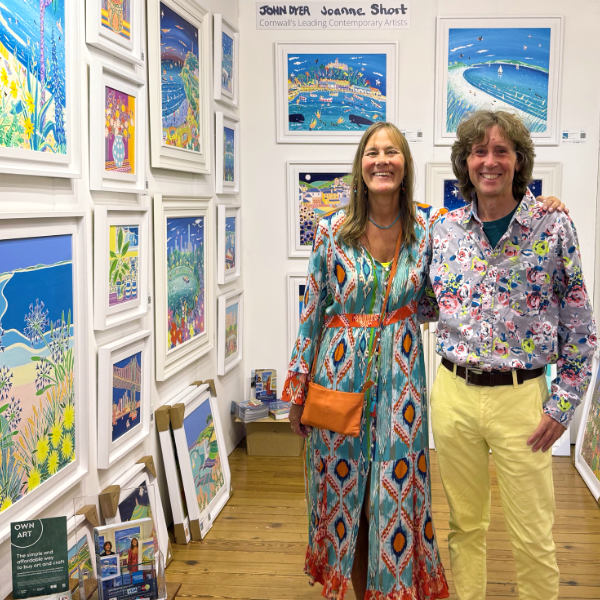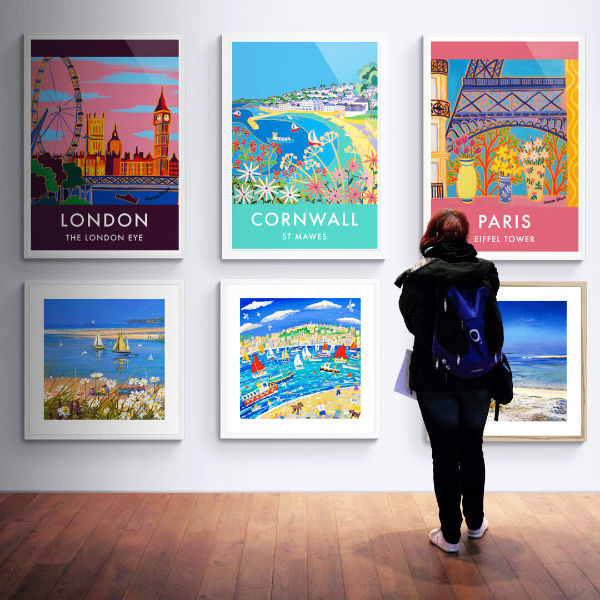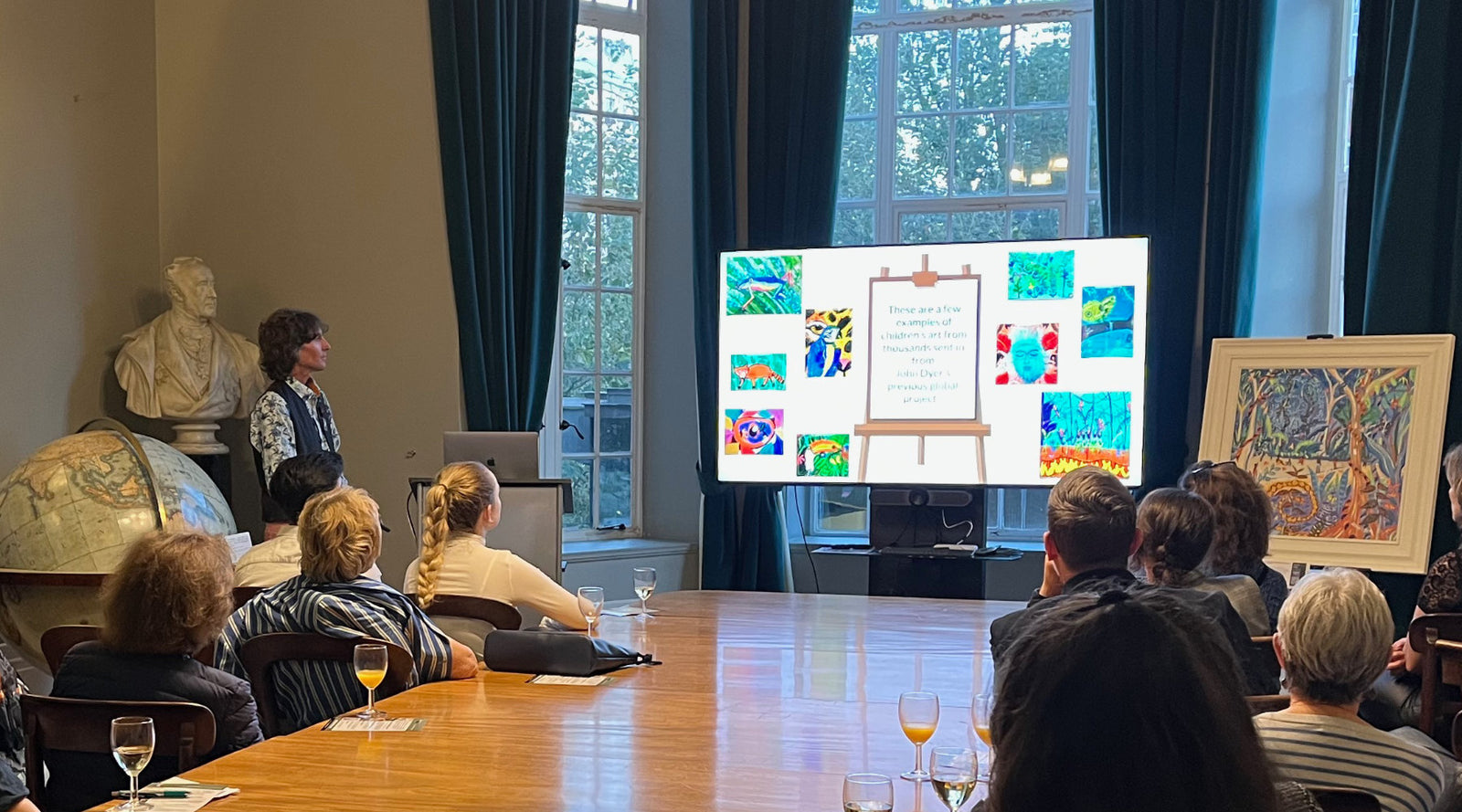
Above: Artist John Dyer (standing on the far left) presented a keynote on environmental art and the Last Chance to Paint initiative in the Council Room of the Royal Geographical Society (RGS) in London in September 2023. Representatives from Arts Council UK, Born Free, Royal Geographical Society, Innova Art, Rohan, Save the Rhino International, Kew Gardens, Volunteers for Future and Ecoflix attended to hear the presentation and view the exhibition in the Director's Gallery at the RGS.
Imagine a world where art not only pleases the eye but also inspires us to protect our planet. Welcome to the fascinating realm of environmental art and the work of John Dyer, a leading environmental artist. Get ready to embark on a journey through this captivating artistic landscape, where creativity and environmental activism go hand in hand.
To view the current John Dyer Last Chance to Paint exhibition at the Royal Geographical Society Director's Gallery you will need to be a member or Fellow of the RGS or contact us at the gallery so we can give your name to the security team. Access is free and available from 10 am to 5 pm Monday to Friday until 18th October 2023.
Buy Environmental Art Online.
Key Takeaways
-
Explore the captivating world of environmental art and discover inspiring works from John Dyer, Andy Goldsworthy, Agnes Denes, Nils-Udo & more.
-
Harness sustainable materials to create awe-inspiring pieces that act as a powerful form of activism for our planet.
-
Learn tips on how to hone your craft and collaborate with artists & activists to make an impactful change in preserving nature!
Understanding Environmental Art
Ecological art, also known as environmental art, explores the intricate relationship between humans and nature, often utilising sustainable materials and acting as a form of activism. Some examples of environmental art include:
-
Sculptures made from recycled materials
-
Installations that highlight the impact of pollution on ecosystems
-
Murals, paintings and prints that depict endangered species, tribal people and their habitats
Above: On the left is Georgie Green, Social Media & Artist Liaison from Procreate with John Dyer at the Royal Geographical Society in London (where he is a Fellow) during the Last Chance to Paint exhibition in 2023. Procreate are a sponsor of John Dyer and his environmental art inspiring young people. Buy John Dyer Amazon Rainforest inspired wall art created using Procreate
John Dyer FRGS, a trailblazer in this field, has collaborated with various NGOs as the artist in residence from the Eden Project, Born Free, Earth Day and many CGIAR groups and organisations to raise awareness about environmental issues.
We will uncover the genesis of this art movement, the objectives and influence of initiatives such as:
-
Dyer’s Last Chance to Paint
-
The Land Art movement
-
The Environmental Art movement
-
The Eco-Art movement
We will also explore a plethora of techniques and approaches that render this art form distinctively exceptional in our exploration of environmental art.
The Emergence of Environmental Art
The seeds of the environmental art movement were sown in the 1960s, with artists aiming to inspire people to take action against environmental damage and promote conservation through the use of natural materials. Aspiring artists found inspiration in the captivating beauty of nature and sought creative ways to express it, drawing from the rich tapestry of art history.
These early pioneers, who highlighted environmental destruction, laid the groundwork for a new generation of artists like John Dyer, who persist in inspiring change and heightening awareness of urgent environmental issues through their work. In 2015 John Dyer revealed to the world a new genre of environment art - Amazon Indian art.
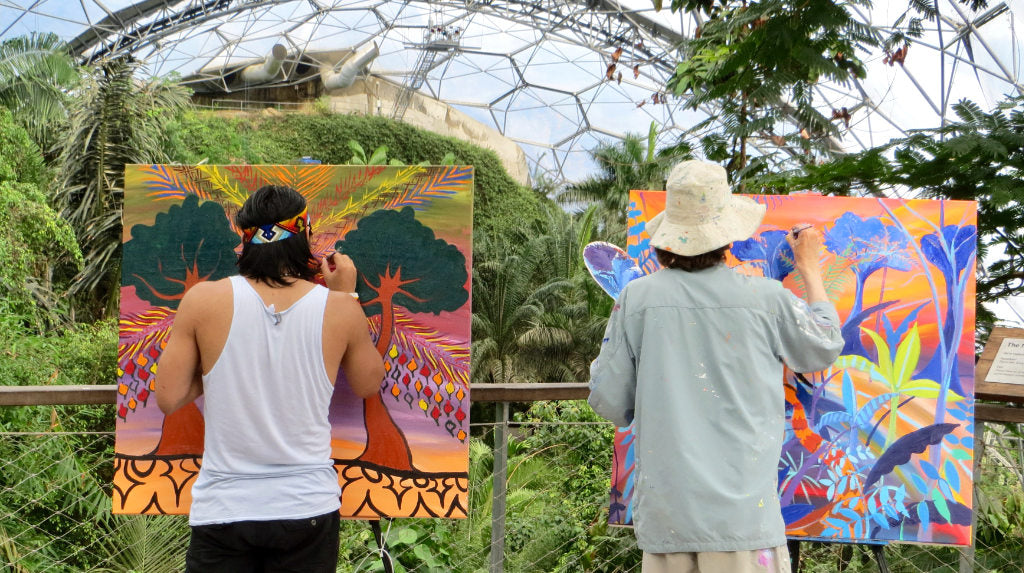
Above: On the left, Amazon Indian Nixiwaka Yawanawá, and on the right, environmental artist John Dyer painting in the rainforest biome of the Eden Project in May 2015. This unique collaboration revealed Amazon Indian art to the world for the first time. A new art genre.
Goals and Impact of Environmental Art: Last Chance to Paint
John Dyer’s Last Chance to Paint project exemplifies the power of environmental art to inspire change. This project aims to motivate children to connect with the planet through art and raise awareness about environmental destruction.
By offering children an immediate, tangible experience of nature’s beauty, Last Chance to Paint underscores the need to preserve our environment for future generations, exemplifying the transformative effect environmental art can have on our world.

Above: Artist John Dyer, the founder of Last Chance to Paint, pictured in the Amazon rainforest with Amazon Indian Nixiwaka Yawanawá during the first Last Chance to Paint expedition in June 2019
Notable Environmental Artists and Their Masterpieces
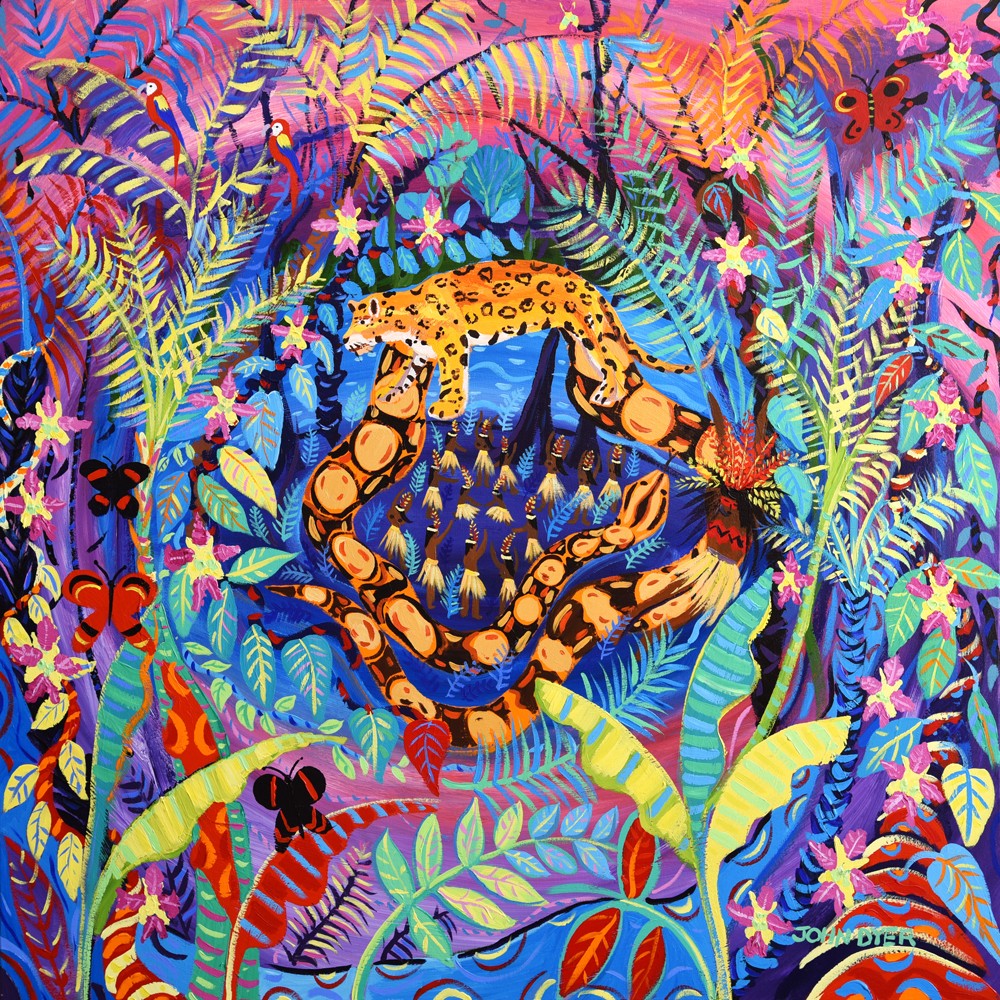
Above: Limited Edition Print by artist John Dyer. 'Nawê - Spirits of the Amazon Rainforest'. The extraordinary image reveals the spiritual realm with a Jaguar and boa constrictor with the Amazon Yawanawá tribe surrounded by the sacred rainforest plants and vines of the tribe. Buy online
In our exploration of environmental art, we come across remarkable artists like John Dyer, Andy Goldsworthy, Agnes Denes, and Nils-Udo, who have harnessed their unique talents to tackle issues such as global warming and environmental devastation. These artists showcase their technical skills and creativity in their masterpieces, and their works stand as powerful testaments to the potential of environmental art to inspire change.
Let’s examine these individuals and their works more closely.
John Dyer: Painting what we risk losing
Above: John Dyer environmental painting created deep in the Amazon rainforest that depicts the Sky Snake Ashuinka and Ground Snake Runua - the spiritual snake of the Yawanawá tribe. View and buy this painting online.
John Dyer, a renowned environmental artist, uses his vibrant and colourful paintings to bring attention to what we stand to lose if we don't act to protect our environment. His work often features endangered ecosystems and species, highlighting the beauty of our natural world and the urgent need for its conservation. One of Dyer's most notable projects is "Last Chance to Paint", a global art project that connects children with indigenous tribes, endangered ecosystems, and endangered species through art.
By painting these fragile and remote places, Dyer aims to inspire the next generation to form a deeper connection with the natural world and take action to protect it.
Andy Goldsworthy: Nature's Sculptor
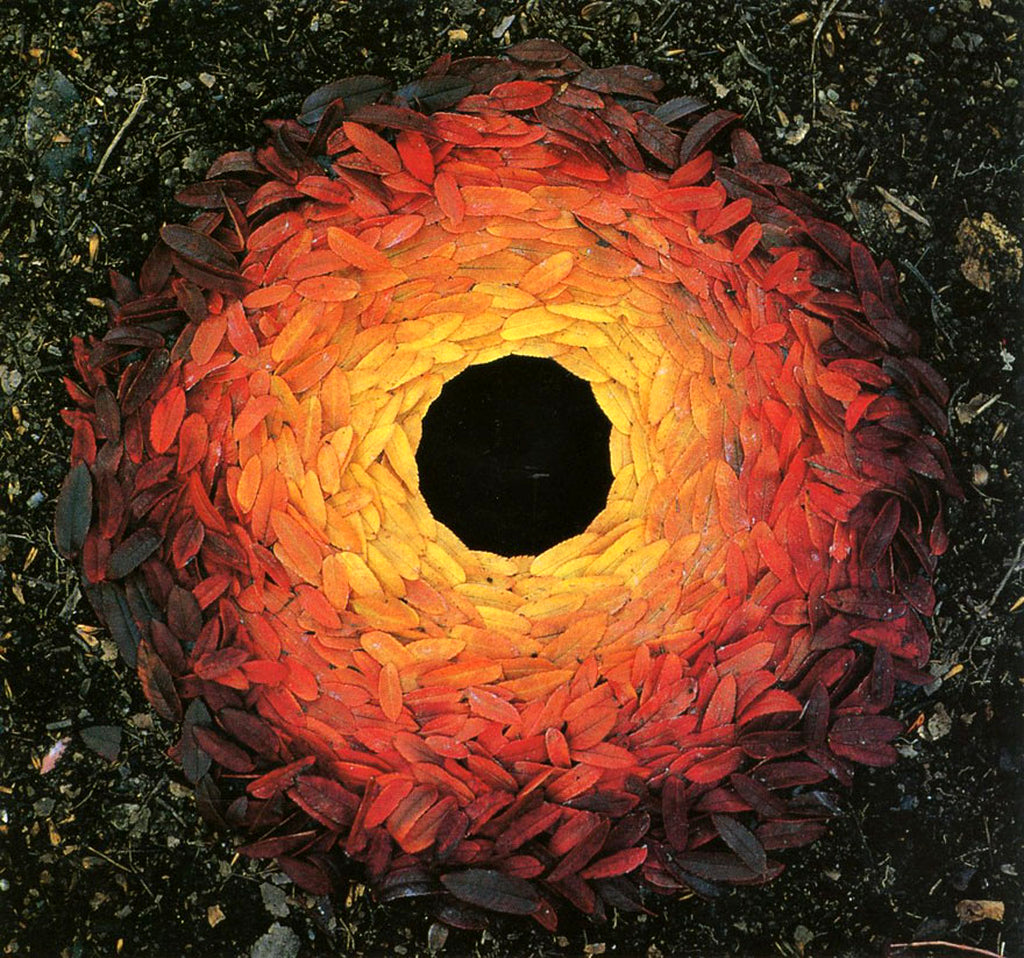
Andy Goldsworthy is often regarded as nature’s sculptor. This British-born artist is known for his stunning site-specific installations, which use natural materials found in the environment. He masterfully incorporates elements such as:
-
mud
-
twigs
-
snow
-
colourful flowers
into his installations, emphasising the beauty and fragility of nature.
Goldsworthy’s work powerfully connects viewers to the natural world, reminding us of the importance of preserving our environment. His art not only showcases the captivating beauty of nature but also serves as a call to action, urging us to become more aware of our impact on the planet and to take steps to protect it.
Agnes Denes: Conceptual Pioneer
Agnes Denes, a Hungarian-born conceptual artist, is a true pioneer of environmental art. Her thought-provoking installations and conceptual approach have made a lasting impact on the art world. Denes is best known for her remarkable work “Wheatfield - A Confrontation,” which involved planting two acres’ worth of wheat in a landfill in Lower Manhattan. This powerful piece served as a commentary on the state of the world at the time, addressing issues such as the economy, inequality, and the Earth.
Denes’ work continues to inspire artists and activists alike, demonstrating the potential for art to bring about meaningful change. Her unique approach to environmental art has paved the way for countless others to follow, and her lasting influence can be seen in the works of many contemporary artists.
Nils-Udo: Creating Utopias in Nature

German artist Nils-Udo is renowned for creating “utopias” in nature, showcasing the potential for harmony between humans and the environment. His awe-inspiring works use natural materials such as stones, wood, and plants to create utopian landscapes in nature. These installations serve as a reminder of the incredible beauty of the natural world and our responsibility to protect it.
Nils-Udo’s work highlights the importance of living in harmony with nature and encourages us to reflect on our own relationship with the environment. As we explore his captivating creations, we are reminded that we, too, can play a role in preserving the beauty of the natural world for future generations.
Techniques and Approaches in Environmental Art
Environmental art is full of exciting possibilities, with artists employing a wide range of techniques and approaches to create captivating works. From site-specific installations and sustainable materials and processes to digital imagery and environment art and paintings like John Dyer's, the world of environmental art offers endless opportunities for creative expression and activism.
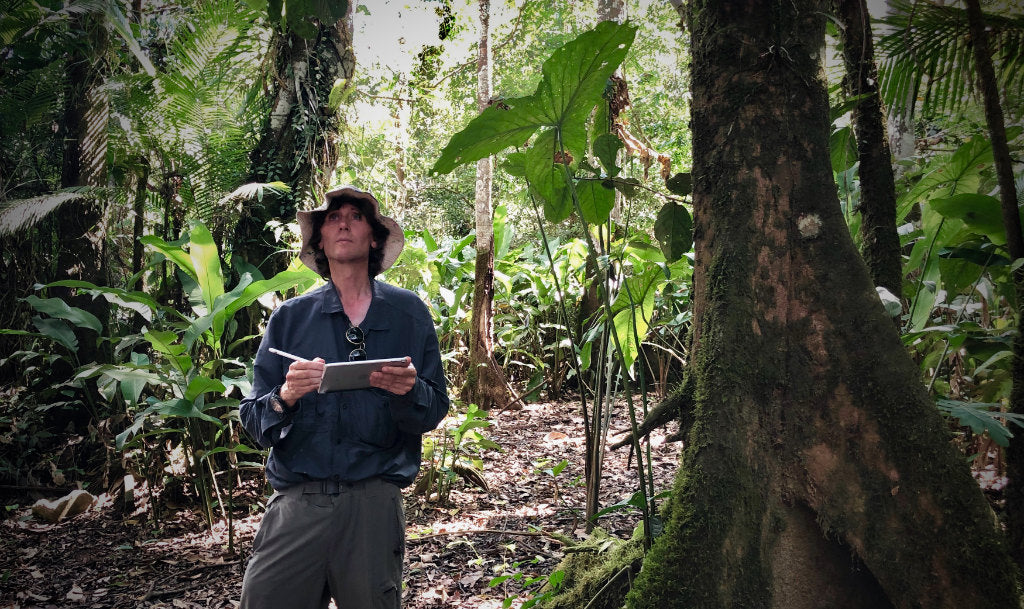
Above: John Dyer at work painting the Amazon Rainforest using an iPad mini and the app Procreate in June 2019
As our exploration continues, let’s probe into these diverse techniques to gain a better understanding of the unique methods artists like John Dyer use to create their visions.
Site-Specific Installations
Site-specific installations are an integral part of environmental art. These installations are specially crafted for a particular location, often using materials found in the surrounding environment. By carefully considering the environment and context, artists can create installations that are not only visually stunning but also resonate with viewers on a deeper level.
These installations serve as powerful reminders of our connection to the natural world and the importance of preserving it for future generations.
Sustainable Materials and Processes
Sustainable materials and processes are essential in sustainable art, ensuring that the environmental art does not harm the environment. By utilising eco-friendly materials and methods, artists can create works that have a positive impact on the environment and inspire others to take action.
Embracing sustainable practices is a crucial aspect of environmental art, and it’s a key factor in the success of artists like John Dyer, who strive to create art that reflects the beauty and fragility of the natural world.
Digital Imagery and Technology
Buy Amazon Rainforest art prints online
In the digital age, technology plays an increasingly important role in environmental art. John Dyer is one artist who has embraced digital tools like the Procreate app on an iPad to create and share his environmental art with a wider audience. The art print above features one of John Dyer's digital paintings from the Amazon Rainforest.
By using digital technology, Dyer has been able to reach more people, inspiring them to connect with nature and take action to protect the environment and he holds three live digital art webinars a year when thousands of children paint with the artist as as he broadcasts his digital canvas from his iPad.
Moreover, digital tools open up new possibilities for environmental artists, allowing them to experiment with new techniques and forms of expression. Some examples include:
-
Digital paintings
-
Virtual reality installations
-
Augmented reality experiences
-
Interactive installations
-
Projection mapping
Technology is revolutionising the world of environmental art, providing artists with exciting new ways to engage with their audience and inspire change by exploring various technical aspects. John Dyer uses satellite technology to broadcast art live from remote locations around the world and is an ambassador for Inmarsat.
Environmental Art as Activism

Above: John Dyer painted wild orangutans in Borneo and used painting as a form of activism to create a call to action for young people.
Environmental art, also known as earth art, can act as a powerful form of activism, addressing critical issues such as climate change and plastic pollution. Through their work, environment artists like John Dyer, David Buckland, and Luzinterruptus raise awareness about the challenges our planet faces and inspire action to address these problems.
These artists illustrate the power of creativity to effect change in the world by employing art as a catalyst.
Artists Tackling Climate Change
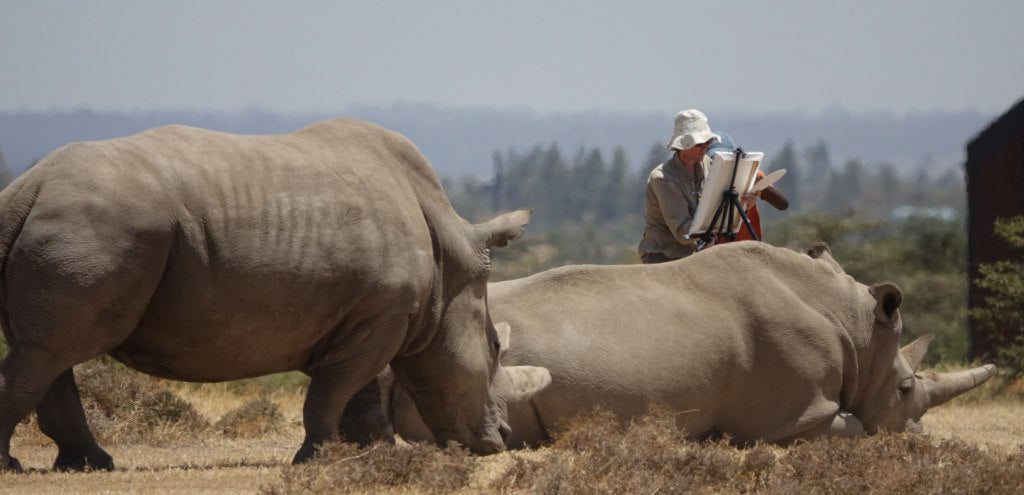
Above: Environmental artist John Dyer uses art as activism to raise awareness as he paints the last two Northern White Rhinos in Kenya
Artists like John Dyer, David Buckland and John Akomfrah use their work to raise awareness about the impacts of climate change on our planet. Through their art, these artists:
-
Highlight the urgent need for action
-
Encourage viewers to consider the consequences of our actions on the environment
-
Motivate change
-
Emphasise the role of art as an instrument for activism
-
Draw attention to the issue of climate change
Buckland’s work, for example, focuses on the detrimental impacts of climate change, blending multiple disciplines in her artmaking to create a powerful message. Similarly, John Akomfrah’s films draw attention to the effects of climate change on various communities, nature, and biodiversity. John Dyer's unique paintings and not-for-profit education project Last Chance to Paint creates a powerful call to action for young people. These artists’ works urge us to take steps to protect our planet for future generations and to be the change.
Art Against Plastic Pollution
Art projects like Luzinterruptus’ plastic waste installations tackle the issue of plastic pollution and encourage action to address this growing problem. By using discarded plastic materials to create captivating installations, these artists not only raise awareness about the issue but also inspire viewers to reconsider their own plastic consumption habits.
Luzinterruptus, an anonymous artistic collective, is known for building awareness around global plastic waste through impressive large-scale public installations and sculptures. Their work serves as a powerful reminder of the urgent need to reduce plastic pollution and protect our environment for future generations. By bringing attention to this critical issue, these artists demonstrate the power of environmental art as a form of activism.
Inspiring Environmental Art Projects Around the World
As we’ve explored the world of environmental art and world building, we’ve encountered inspiring projects from around the globe, such as Ice Watch by Olafur Eliasson and the Battery Park Landfill Project. These projects not only showcase the beauty and power of environmental art but also serve as reminders of the importance of preserving our environment for future generations.
Let’s scrutinize these two extraordinary projects and their influence on our world more closely.
Ice Watch by Olafur Eliasson
Ice Watch is a public installation that brings melting icebergs to urban spaces, raising awareness about climate change. Created by artist Olafur Eliasson and geologist Minik Rosing, this project aims to provide a direct and tangible experience of the reality of melting Arctic ice. By bringing these massive blocks of ice to cities around the world, Ice Watch offers a stark reminder of the consequences of our actions on the environment and the urgent need for action.
The impact of Ice Watch has been immense, with many people deeply moved by the firsthand experience of the melting Arctic ice. As a powerful example of environmental art as activism, Ice Watch serves as a call to action, urging us all to take steps to address climate change and protect our planet for future generations.
Land Art by Agnes Denes: The Battery Park Landfill Project
The Battery Park Landfill Project was an incredible endeavour in the early seventies that transformed a former landfill site into a thriving public park, demonstrating the potential for environmental restoration. By utilising landfill created from New York Harbor dredge, the project built a 92-acre mixed-use community in Manhattan, providing a great benefit to the local community.
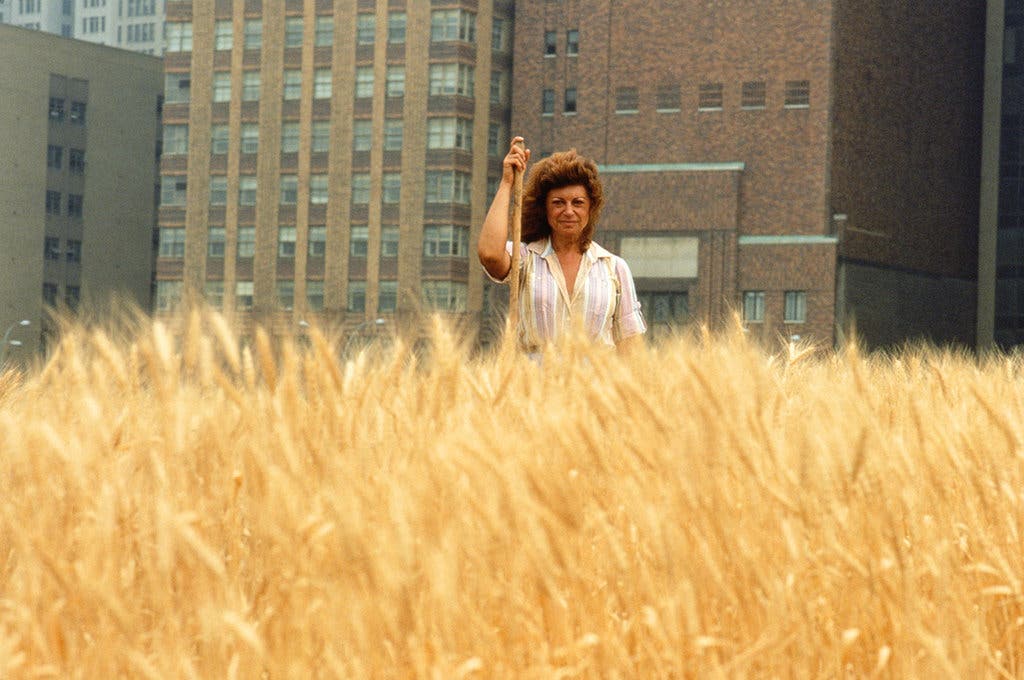
Above: Land artist Agnes Denes pictured in New York in 1982 on the site of Battery Park with 'Wheatfield – A Confrontation'. Battery Park Landfill, Downtown Manhattan. Image Courtesy Leslie Tonkonow
'Wheatfield – A Confrontation', described by scholar and curator Jeffrey Weiss as "perpetually astonishing" and one of Land Art's remarkable transgressive masterpieces (Artforum, September 2008), stands as Agnes Denes's most renowned work. With the support of the Public Art Fund, Denes planted a field of golden wheat on a two-acre landfill near Wall Street and the World Trade Center in lower Manhattan during a four-month period from spring to summer in 1982. This area is now known as Battery Park City and the World Financial Center.
Not only did the Battery Park Landfill Project create a safe and vibrant public park, but it also showed the world how environmental restoration can be achieved, inspiring other similar projects around the world. The success of this project serves as a powerful reminder of the importance of preserving our environment for future generations and the potential of environmental art to make a difference.
Tips for Aspiring Environmental Artists
There are several key factors for those inspired to become environmental artists to consider. Selecting sustainable materials, establishing a connection with nature, and teaming up with other artists and activists are all vital components of creating impactful work.
By following these tips, budding environmental artists can hone their skills and effect a positive change in their surroundings.
Choosing Sustainable Materials
For an aspiring environmental artist who is not a painter but a maker, it’s vital to select sustainable, environmentally friendly materials that have a minimal environmental impact or to use non-environmental objects, like plastic bottles, to make an impact. Some eco-friendly materials to consider are:
-
Bamboo
-
Cork
-
Recycled plastic
-
Natural fibers
You can create unique and captivating pieces that not only look stunning but also have a positive impact on the environment.
Embracing sustainable materials is one aspect of environmental art, but celebrating and raising awareness through art by using digital art, installations or painting are equally important.
Connecting with Nature
Establishing a connection with nature is a fundamental part of becoming an environmental artist. By discovering natural landscapes, watching wildlife, and engaging in activities like gardening and hiking, aspiring artists can develop a deeper appreciation for the natural world and find inspiration for their work.
Connecting with nature can also provide a greater understanding of the natural environment and the challenges it faces, thus inspiring artists to create works that reflect these issues.
Artist John Dyer developed his inspiration by painting global food harvests, like the rice harvest in the Philippines, potato harvest in Peru, the outback of Australia, bananas and cacao in Costa Rica and also by his childhood exploring the natural world on the North coast of Cornwall.
Collaborating with Other Artists and Activists
Teaming up with other artists and activists can offer priceless advantages for budding environmental artists. By joining environmental art organisations, attending workshops and conferences, and participating in art projects that have a positive impact on the environment, you can gain knowledge and skills, network with inspiring people, and create artwork with a powerful impact.
In addition to the practical benefits of collaboration, working with others can also bring a sense of community and support, the opportunity to learn from one another, and the potential to inspire each other. By fostering these connections and working together, aspiring environmental artists can make a significant difference in the world.
John Dyer: Last Chance to Paint Exhibition at the Royal Geographical Society in London
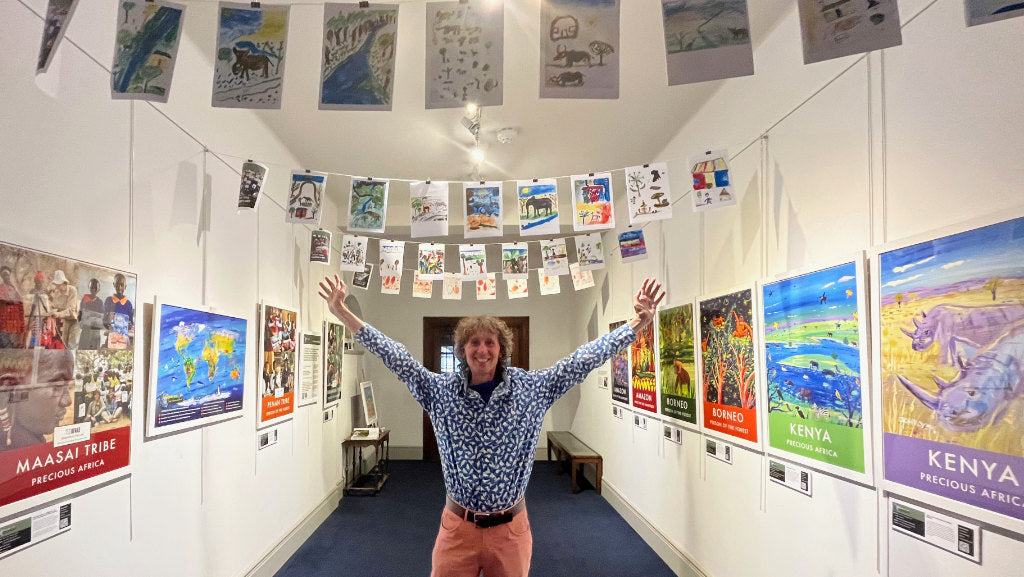
Above: An enticing exhibition by the renowned British artist and Society Fellow, John Dyer, entitled 'Last Chance to Paint', was showcased in the Director's Gallery from Tuesday 12th September to Wednesday 18th October 2023.
This exhibition, a window into the unique educational and artistic endeavour of John Dyer's Last Chance to Paint initiative, presented an array of paintings and images reflecting three tribal communities – the Yawanawá in the Amazon rainforest, the Penan in Borneo, and the Maasai in Kenya. The displayed works, formed by the creative efforts of the artist and children worldwide, encapsulated tribal culture, endangered species and environments, spiritual ceremonies, and the last two northern white rhinos. Alongside these, a selection of photographs featuring the artist painting in Africa, Brazil and Borneo, as well as images of tribal children painting their own endangered environments, were exhibited.
The 'Last Chance to Paint' project, an initiative led by John, aims to connect children to the environment through art. Satellite technology is utilised to share daily videos, blogs and interactive Q&As. The many hundreds of participating schools around the world are invited to accompany the 'Last Chance to Paint' team during their expeditions to tribal communities across the globe. Students in these schools are motivated to create their own paintings alongside John, which are then displayed in the project's online World Gallery so the art bears witness to what we risk losing. The interactive project is raising awareness about environmental issues among school-aged children globally and is fostering deep personal connections with the natural world, prompting children to ponder our planet, our home, and our actions. Schools interested in this engaging initiative can join for free via the website.
Summary
Throughout our exploration of environmental art, we’ve discovered the inspiring work of artists like John Dyer, who use their talents to raise awareness about environmental issues and inspire change. We’ve seen the power of site-specific installations, sustainable materials, and digital technology in creating captivating works of art. We’ve also learned the importance of collaboration and connecting with nature. As we’ve witnessed the impact of environmental art around the world, we’re reminded of our responsibility to protect our planet for future generations. Let us all take inspiration from these artists and use our own creativity to make a difference in the world.
Frequently Asked Questions
What does an environmental artist do?
Environment artists create digital 3D environments for films and video games, constructing world assets such as structures, terrain and props. They often start with 2D art created by a concept artist and turn it into a believable environment in 3D, adding detail to the overall scene with set dressing.
What is an example of an environment artist?
Agnes Denes is one of the best-known environmental artists, renowned for her groundbreaking Wheatfield project near Wall Street in Manhattan. Other renowned works include Robert Smithson's Spiral Jetty in Utah, Andy Goldsworthy's 'Procrastination' and Andrew Rogers' 'Rhythms of Life' series in Ibiza, Spain and John Dyer for his Last Chance to Paint initiative.
Who are the artists for environmental impact?
Jenny Kendler, Nils Udo, John Dyer, Jean-Max Albert and Piotr Kowalski are the inspiring artists dedicated to environmental impact, raising awareness about climate change with their powerful artwork and making a difference in the world.
How can environmental art be used as a form of activism?
Environmental art is an effective tool to bring awareness to environmental issues such as climate change and plastic pollution, inspiring people to take action. John Dyer's Last Chance to Paint project is the leading educational and arts project achieving this.
What techniques and approaches are used in environmental art?
Environmental art utilises techniques such as site-specific installations, sustainable materials and processes, and digital imagery and technology to create its works.

